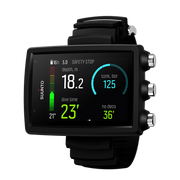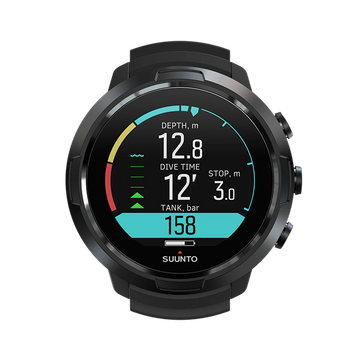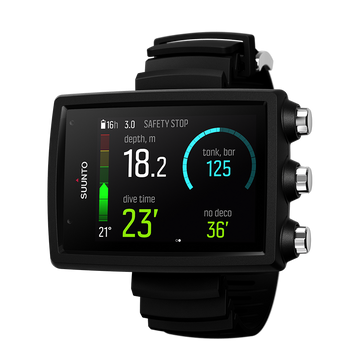

Suunto-blogg

Proving electric adventure is the future
Greg charges his electric car on route to the mountains. © Greg Hill
Record-breaking ski mountaineer and Suunto ambassador Greg Hill is no stranger to pushing the boundaries. In 2010, he climbed two million feet (610,000 m) in a year, and in March, 2014, he skied 100,000 ft vertical. This time around he has climbed 100 summits without using any fossil fuel, demonstrating that one can be a mountain mad adventurer and also care for the planet.
“I really care about the environment and I really want to walk the talk,” Greg says. “We have to be conscious about our impacts on Earth.”
“Electric Greg” premiered at the Banff Mountain Film Festival this year. Watch below and see Greg and his adventure buddies test the limits of an electric car designed for the city in rugged backcountry.
Electric Greg premiers online at 9 p.m. CET on December 3rd. Stay tuned and join Greg and the film's director Anthony Bonello for a live chat!
What inspired the project?
It was a long time coming. Forever I’ve recognised the hypocrisy of being an outdoorsy person and yet the vehicles we use for our means of access aren’t great for it. It’s been a struggle in the back of my mind for a long time.
What changed?
When I finished my two million feet project I knew my carbon footprint had been huge. I was driving my big truck all over and had a trip to South America. So in April 2012 I decided to cycle to all my adventures and not use any gas that month. It was a fun month. I climbed 11 summits and had an incredible journey. But it was pretty challenging because nobody joined me. It’s not something anyone is going to jump on board with because it’s just too hard. It was a great month, but I wasn’t able to inspire anybody.
Then I broke myself in an avalanche in 2014. I spent hours, days and months sitting on the couch recovering and reflecting and thinking about what I could do to make a difference. Finally in 2016 electric cars were coming on to the market. The technology was finally there. I sold my truck in 2016, and gave up heliskiing. Finally we had the technology to get us to the trailhead and allow us to be a little bit better. It took the big crash in the avalanche to really stop and look at my kids and realise that if I had any influence I should try to influence a more positive change.
Is electric adventure the future?
I love the fact that I've been an explorer of first ascents and traverses and stuff, pushing human limits, but I love the fact that I'm also an explorer of this whole new way of adventuring. I'm pushing that and hopefully it becomes the norm. I’m not perfect, but humans are great at evolving so lets put our minds to doing that. There is a great emotional reward. We all have to stand strong and battle.
The technology is changing so rapidly. The ability to recycle batteries is getting better and better. It’s the future. In March next year I’m getting an electric snowmobile. This is my third winter with my little electric car and I definitely can’t wait to get to more trail heads. Your circle of access is much smaller if you are only accessing trail heads off the side of the road. A snowmobile gets you deeper, and keeps the exploration fun. My circle of adventure will widen. I'm ready to adventure deeper!
Tell me about your electric city car?
It has a range of about 150 km. I've driven it down to Jackson Hole, which is 2000 plus km, and down to California. It’s done close to 100,00 km now. When I go on trips in it, I definitely have a little bit of a grin, they call it the “electric smile”. It’s offered a way to help me be better, to reduce my carbon footprint.
What has been most challenging about this project?
My family was worried about what it was going to change for them. Not flying for vacations and so on. I do my best to make it less hard on them. They have had to adopt all the challenges that come with the electric challenge. Some of my sponsors were initially skeptical, too. There is so much fear around change.
I have received offers to go and explore the world, to ski and summit peaks in remote places, there has definitely been lots of trips I've had to say no to. As good as I try to be I do sometimes fly. I went to a Utah athletes summit, but once I landed there I rented an electric car. There are always options to be a little better.
Lead images: © Bruno Long
Read other articles:
Born to shred in the Arctic
7 tips for running in the dark
7 winter trail running tips
7 great things about running in winter

Jill Heinerth joins diving hall of fame
Suunto is proud to announce its ambassador Jill Heinerth has been inducted into the International Scuba Diving Hall of Fame, 2020. An honor she more than deserves thanks to her incredible contribution to diving and exploration.
As a pioneering cave diver and explorer, documentary maker and author Jill Heinerth has educated and inspired people around the world about our incredible underwater world and the human impact on it. The International Scuba Diver Hall of Fame is an annual event that recognizes people who have significantly and positively impacted the industry through education, exploration, adventure and more. Founded by the Cayman Islands Ministry of Tourism in 2000, the award ceremony will take place in September 2020 in the Caymans.
During an announcement ceremony at DEMA Show, 2019, Jill spoke of what the award means to her.
“Such an amazing honor for a young woman who started her professional diving career in the Cayman Islands a long time ago. This is really fantastic at a time in my life that is very meaningful where I am just releasing my new book Into the Planet and a new documentary, Under Thin Ice. Thank you for this incredible honor! I look forward to visiting the Cayman Islands to accept it.”
There were three more nominees announced for the 2020 induction and they are Handicapped Scuba Association Founder Jim Gatacre, DEMA Executive Director Tom Ingram, and Undersea Hunter Group Founder Avi Klapfer.
Jill was at the Suunto booth this year signing copies of her incredible memoir, Into the Planet.
Released in August, Into the Planet is a thrilling insight into places inside the Earth you may not have imagined exist, but where Jill has dived. She bravely illustrates intense political issues and presents hard evidence about the impacted ice caps and beyond.
Her autobiography explores life-or-death decision-making in critical underwater situations, the pain and difficulty involved in recovering the dead bodies of her tragically lost friends from caves that no one else in the world has the ability, training, and mindset to access due to such extreme conditions.
Speaking at a Suunto function during DEMA Show, 2019, Jill talked about her memories, which are fascinating for both divers and non divers thanks to their important messages.

Welcome to Suunto Summit!
The fifth instalment of Suunto Summit, a celebration of our community and our collective passion for sport and the outdoors, will be held in January 2020 in Ylläs, in Finnish Lapland. We will start the weekend with a visit to Suunto factory and Suunto HQ in Vantaa and then travel by an overnight train to Ylläs, north of the Arctic Circle, to experience the beauty of northern Finland.
The participants for Suunto Summit 2020 are: Alberto from Spain, Alexandre from Brazil, Alpinefex from Germany, Dorn from USA, Lotta from Finland, Maja from Sweden, Majo from Philippines, Marie from UK, Matteo from Italy, Max from USA, Philipp from Germany, Sandra from Australia, Sawna from USA, Thumb K from Korea, and Xiaohua from China. Welcome to Suunto Summit!
Thank you to all who applied! We are humbled to have such a passionate community. It was very inspiring to hear your stories and to get to know you a little bit. Happy adventures and hope to meet you another time!Excitement at the 2018 Suunto Summit. Watch the event recap here
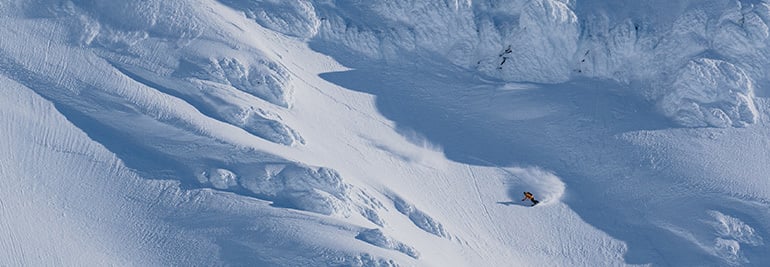
Born to shred in the Arctic
Making his adventures sustainable is a major focus for Antti now. © Jaakko PostiWinter has nearly arrived in Lapland, where Finnish splitboarder Antti Autti is preparing his body and mind for a year long adventure project – in collaboration with Suunto – that will test his limits.
In a week’s time, the long polar night will arrive, leaving only two hours of daylight every 24 hours. That’s not stopping the 34-year-old freerider and filmmaker from heading out into the inky blue night to do what he loves.
“The polar night is not dark in my opinion,” he says. “The Arctic has incredibly changing light; each season is different. The winter here is really magical.”Exploring remote areas of Lapland requires careful planning, Antti says. © Jaakko Posti
Antti has completed the first part of his new adventure film project, Roam, in which he and his friends explore new freeriding territory in Lapland in each season of the year. With the autumn adventure behind him, a 10-day winter trip comes next.
“It's a great challenge for me as a professional freerider and I could not be more excited about this collaborative journey I am about to share with Suunto,” Antti says. “No matter if I’m out running trails or searching new lines to ride over winter, Suunto helps me to reach my goals and to move safely and smartly through the wilderness.”
Antti was born and raised in Rovaniemi, the capital of Lapland, and his family home neighboured Ounasvaara ski resort. As a kid he tried team sports, but says he didn’t fit in. Out skiing one day when he was nine, he watched in awe as a snowboarder performed impressive tricks. When Antti tried snowboarding a year later, he was hooked. “I discovered I could explore anywhere I want if I had the speed,” he says.
When he was 13 Antti entered his first competition, and while still a rookie earned a place on the Finnish national snowboarding team. While on the team, he won the world championships, X Games and nearly all the biggest competitions world wide.
“In 2010 I felt like I needed to do more and not what everyone expected from me,” he says. “I wanted to ride powder and learn about mountains so I quit competing and began freeriding.”
Svalbard Unplugged from Antti Autti on Vimeo.
Antti lives only 200 m from his family home and continues to find new terrain to freeride. He and his friends, for example, rode new lines on remote Svalbard Island, located halfway between the top of Norway and the North Pole. He does epic tours through rugged terrain in northern Sweden, Finland and Norway. “The whole of Lapland is an amazing place for adventure,” he says.
His new adventure film project has an important difference to his previous projects; it will be conducted mostly under human powered steam. “The key point of the whole film is to spend the whole winter in the north, to throw ourselves out there, and hopefully to inspire people to leave motorised vehicles out, and to instead use human power,” Antti says. “I really want to focus on doing things in a way that respects nature.”
Getting physically and mentally ready for the coming winter adventure is Antti’s main focus now. Strength training, long aerobic zone one and two workouts and interval sessions help him maintain the base fitness that long distance tours through deep snow demand. This makes his adventures more enjoyable, and safer. “The best way is to stay safe in the north is to have a motor that keeps on going and doesn’t stop,” he says.
Lead images: © Jaakko Posti
Read more related articles:
7 tips to find a safe track up the mountain
8 avalanche safety checks to tick off before the ski season
Knowing the ropes – staying safe with crevasse rescue online
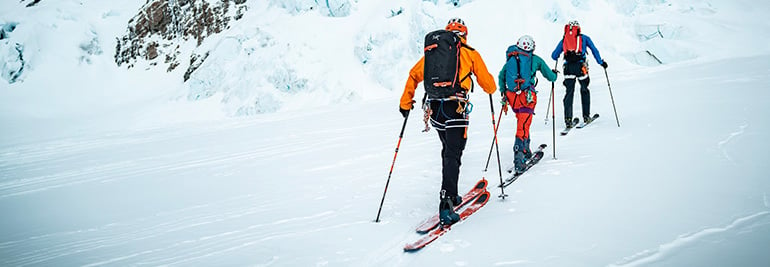
7 tips to find a safe track up the mountain
© Mark SmileySuunto ambassador, filmmaker, and alpine pro Mark Smiley is currently in New Zealand, and preparing to climb Mt Cook (3724 m), the country’s tallest mountain.
“My phone is downloading the topographical and satellite images for Mt Cook as we speak,” he says. “Having never been here before, I want to make sure I climb the right couloir.
“Selecting the right path up a mountain is a fun art to practice. The goal is to get to the top with as much go-juice in your legs as possible so you can slay the down like a boss.”
Mark is passionate about outdoor education and helping people to stay safe in the mountains. He has just released his latest online training course, perfectly timed to get skimo fans ready for the winter. The Ultimate Guide to Backcountry Skiing & Ski Mountaineering online course is a deep dive into all aspects of the sport.
The first 200 skiers to sign up for the course before November 25, and who use this coupon code: EARLYBIRD40, will receive a 40% discount on the original price. The first 50 students to sign up will also get Mark's Crevasse Rescue online course for free!
“Really I made this new course for my 26-year-old self,” Marks says. “Had I had this helpful resource 12 years ago, I would have been skiing bigger lines, more safely, in a fraction of the time.”
As a taster, here are Mark’s 7 tips to find a safe track up the mountain.
Pre trip
To make this article easier to digest, we’ve separated Mark’s tips into pre and in-trip groups. “The key is to do your homework,” he says. “That is the first priority.”
Signs of a good track
1. It doesn’t expose you to avalanche risk. 2. A gradual mellow slope, with a nice run out, where the avalanche debris would have plenty of space to fan out.3. Look for nice straight lines with a consistent incline. Eighteen degrees is a pretty good place to start. 4. Switchbacks that are in the best place possible, often that’s just downhill of trees (if you are below the treeline), or in any slightly less steep areas.5. Following a ridgeline or pushing up through dense forest is usually safer than ascending via a face and sparse forest.
Signs of a risky track
1. Unsupported convex rolls are a big avalanche risk. A convex roll is a part of the slope that bulges out. Imagine putting a salad bowl against a wall, then putting snow on the top. The snow would slide off because the bowl doesn't support it.2. Terrain traps: keep a lookout for things that could make a fall really bad, like being thrown into a creek, off a cliff, into a ravine, or into a crevasse.3. I like to look for a track that doesn't expose me to cornice, rock or icefall hazards.
Use your Suunto 9
You can download the track to your watch and then you can follow along. You can create routes in Suunto app with terrain maps, heat maps, as well as use existing activities to create routes. And you can use GPX files you have created in other services. ”I use this track as a "helpful suggestion" when navigating in whiteout conditions on a glacier, or in an area that I’ve never seen before."
Get techy
Download Gaia GPS, and get the subscription so you can take map files offline, and learn how to use it well. This app is seriously like cheating at navigation. You can download topo maps, satellite images, put a route line on the map where you want to go, and then navigate with ease.
If you want to learn more about how I use the map, check out my online course at www.mtnsense.com. In less than an hour you’ll be on your way with new-school navigation.
Click here for Mark's eight avalanche safety checks
© Mark Smiley
On the trip
Don’t be a sheep
Looking up and ahead is key to your ascent. Don't be a sheep by just walking up the skin track. Make decisions about where you are going. Most of the time that will be an existing skin track, but not always. Snow changes over time, and so too must the skin track.
Listen to you heart
The goal is to keep your heart rate at a consistent level most of the tour as opposed to revving it up and then dropping it down. Choose a track that keeps a constant slope angle, making it easier to get in the groove, keep your heart rate about the same the entire climb, and just enjoy the rhythm of movement.
Not too steep
Another skill is finding the perfect steepness that minimizes linear distance, without making it too steep. If you’re slipping out, you’re wasting energy.
Read more articles like this:
8 avalanche safety checks to tick off before the ski season
Knowing the ropes – staying safe with creavsse rescue online
Lead image: © Mark Smiley
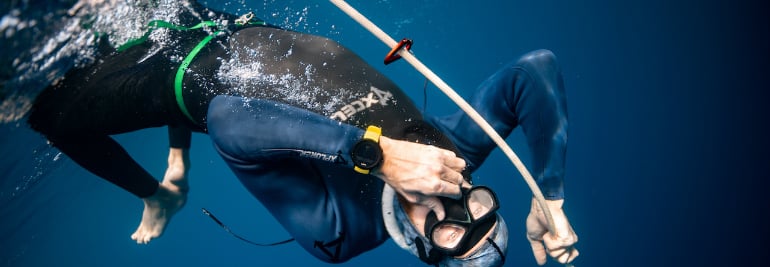
Experience the Blue Element freediving competition
Athletes from across the globe are gathered and ready to go as the third Blue Element fins off in Dominica!
Blue Element kicks off tomorrow for their 3rd event in Dominica. Suunto Dive caught up with one of the founders, Johnathan Sunnex, to find out what it is all about before media manager and freediver Francesca Koe takes over our Instagram feed tomorrow.
Photo by Daan Verhoeven
What is Blue Element?
Blue Element is an international freediving experience that encompasses multiple days of diving, beach clean-ups, island exploration and much more! It is held annually in the picture perfect island of Dominica! Sofia Gomez Uribe and I founded Blue Element freediving in 2016.
This is the third BE competition which was founded in 2016. Hurricane Maria prevented the 2017 edition, but last year the BE team were able to re-establish the event despite the country still being in recovery mode after the hurricane devastation.
The event is held in Soufriere Bay/Scotts Head in the very south of Dominica. Dominica is a small island nation, a part of the Lesser Antilles island chain in the Caribbean.
Why is the location so amazing?
The Soufriere Bay offers world class conditions year round, unlike any other location on earth. The water temperature ranges between 26-30°C, the visibility is between 20-30m and there are no waves, no currents and effectively no depth limit. To add to this, the bay is surrounded by high mountains carpeted with lush tropical jungles creating the perfect backdrop.
The custom built freediving platform is currently set in 160 m and just a five minute swim from shore.
Are you expecting any records?
The Blue Element team pride themselves in creating an atmosphere where athletes can perform at their very best. Dozens of national records and several world records have already been set here over the past four years and we expect this event to be no different!Blue Element 2019 will be attended by 30 athletes from around the world, including many national record holders, vice and world champions. We can expect to see many records fall at this event including national, continental and possibly world records.
What disciplines compete and on what days?
Athletes have the choice to compete in as many or as few of the competitive depth disciplines as they choose. There are six days of diving split into three sets of two. We are expecting 30 athletes to be competing this year and more than 150 official performances.
Have you seen the event grow?
Hurricane Maria was quite a setback and it took a lot to regain momentum. The event continues to grow each year and this year we will have almost three times the number of athletes than attended the inaugural competition.
Photograph by Daan Verhoeven
What can the athletes win?
Suunto D6i’s, Suunto D5’s, carbon blade Alchemy fins and shirts, custom made Elios wetsuits, Octopus nose prize packs, All-Swim swimwear, high end Pacsafe back packs made of recycled fishing nets, ADIDAS shirts, Recycled plastic Blue Element T-shirts, custom medals.
Who are the judges?
Two of the world’s leading judges, Carla Hansen and Vedran Milat.
Who runs the safety team?
Chief of Safety Louisa Collyns of the UK returns to lead our experienced team of safety divers. The safety team have been hand selected and are comprised of several 80-90m divers in their own right.
Will the rules be governed by AIDA or CMAS standards?
AIDA International.
Who is taking the official pictures?
Predominantly the man, the myth the legend, Daan Verhoeven. I will likely join him behind the camera for some session.
Will you have Dive Eye?
Not this year but the event will be covered by our professional media team with event videos and live streaming from the platform. We have cameras placed strategically to get all of the best angles from both above and below the surface! You will be able to catch the live stream from our Facebook page, and the videos will be uploaded to our social media channels. We will also be taking over the Suunto Dive Instagram feed live from the dive platform.
Photograph by Daan Verhoeven
What is your history in freediving?
I have been involved with freediving since 2011. I competed for the first time the same year in Kalamata for the Med Cup and then the AIDA World Championship. I placed somewhere in the middle of the field, but these events and the athletes who were in attendance inspired me to make a full commitment to freediving. I vowed to myself that when I would return I would be there for a podium placing.
I moved to Egypt and I started to teach and train full time. Living next to the ocean mean't I had easier access to depth which allowed me to progress quickly and I made my first dive below 100 m in November of 2012. The following year I returned to Kalamata for the AIDA Depth World Championship and, as I had hoped, this time I managed to place third in free immersion, winning a bronze medal. I ranked third overall for depth diving in 2012 and 2013 with deepest official results of 105 m CWT, 101 m FIM and 65 m CNF set in the Bahamas at Vertical Blue.
After the death of two friends (fellow freedivers) I switched my focus towards coaching and safety diving. I had thoughts about leaving the sport, but I soon realised that that wouldn’t change anything and that I would be better off staying and trying to make the sport safer. I ran safety seminars and returned to Long Island in the Bahamas, this time as the Chief of Safety and co-organiser. I hand selected a group of free divers that I knew would be up to the task of looking after the deepest divers in the world pushing their bodies to the absolute limit. I applied the same mindset to running the safety team to what I had used in my own personal training. We approached safety diving with performance in mind. Team bonding for cohesion, rescue drills and emergency training to sharpen our skills, incident reviews for learning opportunities and to strive for improvement. This approach has since been adopted by many other events and has set the standard for the international freediving community.
Since then, I have coached athletes to more than 70 national and continental records as well as seven world records. I am an instructor trainer with AIDA International and I continue to organise freediving events. I enjoy exploring and documenting the underwater world with my camera, and have dived in all continents, including both polar regions.
Will you compete?
Once the competition is underway and everything is running how it should, then yes, I plan to take off my organizers hat for a few minutes each day to perform some dives!
Photograph by Daan Verhoeven
Any hot tips or words of inspiration you would like to share?
Freediving, like life, is often a trial of tribulations. Success takes patience and persistence but inevitably hard work and determination pays off.
Links:
Photography by Daan Verhoeven
Blue Element Facebook
Blue Element Instagram
Blue Element Website








